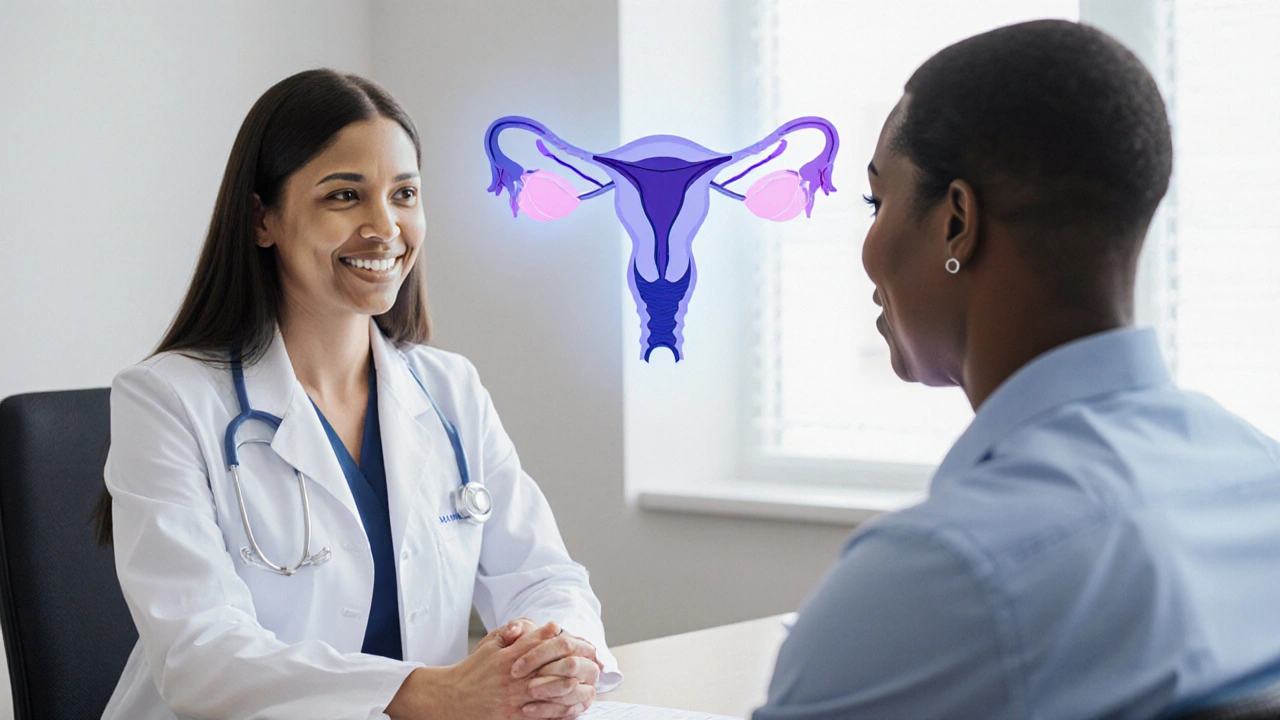Hormonal imbalance is a condition where the body’s endocrine system produces too much or too little of one or more hormones, disrupting normal physiological processes. It often manifests in irregular ovulation, abnormal menstrual bleeding, weight changes, and mood swings. Common culprits include polycystic ovary syndrome, thyroid disorders, and elevated prolactin levels.
When the delicate hormone dance that powers the menstrual cycle goes off‑beat, the consequences ripple through fertility, mood, and overall health. Below you’ll find a step‑by‑step look at the main hormones, how they interact, what throws them off, and what you can do to get back on track.
Key Hormones that Drive the Cycle
Estrogen is a steroid hormone produced primarily by the ovaries. It builds the uterine lining and prepares the body for a potential pregnancy. Typical serum levels rise during the follicular phase (≈100-400pg/mL) and dip after ovulation.
Progesterone is released by the corpus luteum after ovulation. It stabilises the endometrium, making it receptive for implantation. Normal luteal‑phase concentrations hover around 5-20ng/mL.
Luteinizing hormone (LH) is secreted by the pituitary gland and triggers the final maturation of the egg and its release (ovulation). A typical mid‑cycle surge spikes to 20-100IU/L.
Follicle‑stimulating hormone (FSH) promotes follicle growth in the ovary. Baseline levels range from 4-12IU/L in the early follicular phase.
Cortisol is the primary stress hormone. Chronic elevation can suppress gonadotropin‑releasing hormone (GnRH), leading to lower LH and FSH output.
Common Disorders that Skew Hormone Balance
Three conditions account for most cases of disrupted ovulation and bleeding:
- Polycystic ovary syndrome (PCOS) is characterised by hyper‑androgenism, insulin resistance, and anovulatory cycles. About 10% of women of reproductive age meet the diagnostic criteria.
- Thyroid disorders - both hypothyroidism and hyperthyroidism - alter basal metabolic rate and interfere with GnRH pulsatility. Up to 20% of women with menstrual irregularities have an underlying thyroid issue.
- Hyperprolactinemia (excess prolactin) suppresses GnRH, leading to low LH/FSH and missed ovulation. Pituitary adenomas are the most common cause.
How Hormonal Imbalance Messes with Ovulation
Ovulation hinges on a precise surge of LH triggered by a steady rise in estrogen. When estrogen stays too low, the LH surge never reaches the threshold, and the egg remains trapped. Conversely, excess estrogen can cause a premature LH surge, leading to a “luteinised unruptured follicle” - essentially a false ovulation.
Insulin resistance, common in PCOS, boosts ovarian androgen production, which in turn blunts the estrogen‑LH feedback loop. The result is chronic anovulation, often observed as irregular or absent periods.
Impact on the Menstrual Bleeding Pattern
Progesterone’s main job is to stabilise the endometrium after ovulation. Without adequate progesterone, the uterine lining fragments unevenly, producing spotting or heavy bleeding (menorrhagia). In hypothyroidism, reduced progesterone synthesis can prolong the proliferative phase, leading to longer cycles and scanty flow.
Elevated cortisol also shortens the luteal phase because stress‑induced ACTH spikes suppress LH, curbing progesterone output. Women often report “short‑lived periods” during high‑stress periods such as exam weeks or major life changes.

Diagnosing Hormonal Imbalance
A thorough work‑up combines symptom review, physical exam, and targeted labs:
- Day‑3 FSH, LH, estradiol, and progesterone levels to gauge baseline pituitary‑ovarian function.
- Mid‑cycle LH surge (or LH‑to‑FSH ratio) if ovulation timing is uncertain.
- Thyroid panel (TSH, free T4) to rule out hypo‑ or hyper‑thyroidism.
- Prolactin level, preferably after an overnight fast, to detect hyperprolactinemia.
- Fasting insulin and glucose to assess insulin resistance, especially in suspected PCOS.
Ultrasound can visualise ovarian morphology (e.g., ≥12 follicles of 2‑9mm in PCOS) and endometrial thickness, providing a visual complement to the hormone numbers.
Therapeutic Strategies to Restore Balance
Treatment is tailored to the underlying cause, but several pillars apply across most scenarios:
- Lifestyle modification: regular aerobic exercise and a Mediterranean‑style diet improve insulin sensitivity and lower androgen levels.
- Hormonal therapy: combined oral contraceptives (COCs) regulate estrogen and progesterone, suppressing excess androgen in PCOS and stabilising the endometrium.
- Metformin: an insulin‑sensitising agent that reduces ovarian androgen production, often restoring ovulation within 3-6months.
- Thyroid hormone replacement (levothyroxine) for hypothyroidism or antithyroid drugs for hyperthyroidism, normalising menstrual rhythm.
- Dopamine agonists (cabergoline, bromocriptine) lower prolactin levels, allowing GnRH to resume its normal pattern.
In refractory cases, ovulation induction agents such as letrozole or clomiphene citrate are prescribed to jump‑start the LH surge.
Comparison of Major Causes of Hormonal Imbalance
| Condition | Typical Hormone Pattern | Primary Symptom | First‑line Treatment |
|---|---|---|---|
| PCOS | Elevated LH:FSH ratio, high androgens, insulin resistance | Irregular cycles, hirsutism | COC + Metformin |
| Thyroid disorder | Altered TSH (high in hypothyroid, low in hyperthyroid), variable estrogen | Fatigue (hypo) or heat intolerance (hyper), menstrual changes | Levothyroxine or antithyroid meds |
| Hyperprolactinemia | High prolactin, suppressed GnRH, low LH/FSH | Galactorrhea, amenorrhea | Dopamine agonist |
Related Topics to Explore Next
Understanding how hormonal disturbances affect reproduction opens doors to several adjacent subjects. Readers often move on to learn about:
- The role of insulin resistance in fertility and its link to diet.
- How endometrial health influences implantation success.
- Natural approaches, such as adaptogenic herbs, for managing stress‑related cortisol spikes.
- Long‑term cardiovascular risks associated with chronic hormonal imbalances.
Each of these topics expands the picture of reproductive endocrinology and offers practical tips for a healthier cycle.

Frequently Asked Questions
Can stress alone cause missed periods?
Yes. Chronic stress elevates cortisol, which suppresses GnRH release. Without GnRH, the pituitary drops LH and FSH, often leading to anovulatory cycles and skipped periods.
Why does a woman with PCOS still have high estrogen?
In PCOS the ovaries produce excess androgens, which are aromatised into estrogen in peripheral fat tissue. The resulting estrogen is often unopposed because ovulation (and thus progesterone production) does not occur.
How quickly can thyroid medication regularise my cycle?
Most women notice cycle regularity within 4-6weeks after reaching a stable thyroid‑hormone level, though full normalisation may take up to three months.
Is it safe to use birth‑control pills just to fix irregular bleeding?
For most women, combined oral contraceptives are a safe and effective way to stabilise estrogen and progesterone, reducing irregular bleeding. However, a medical review is essential if you have blood‑clotting disorders, hypertension, or migraines with aura.
Can diet alone improve hormonal balance?
A balanced diet rich in whole grains, lean protein, and omega‑3 fatty acids can reduce insulin resistance and lower androgen levels, which in turn supports regular ovulation. It’s most effective when paired with regular exercise and, if needed, medication.
